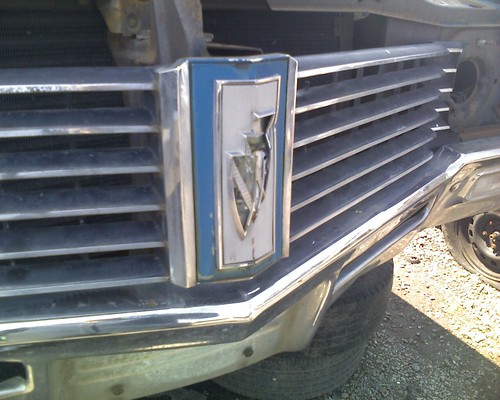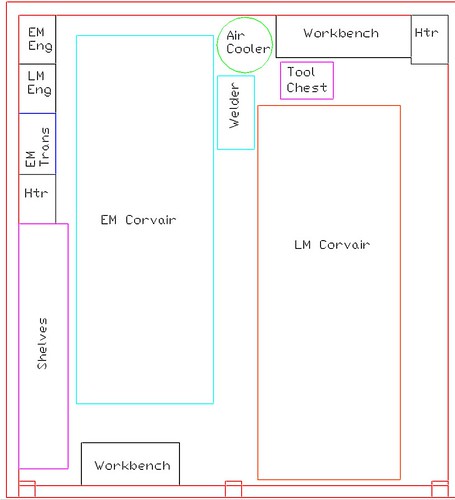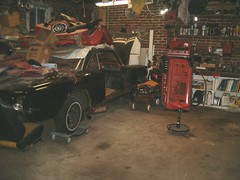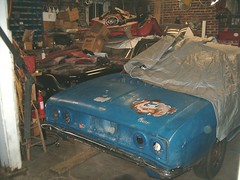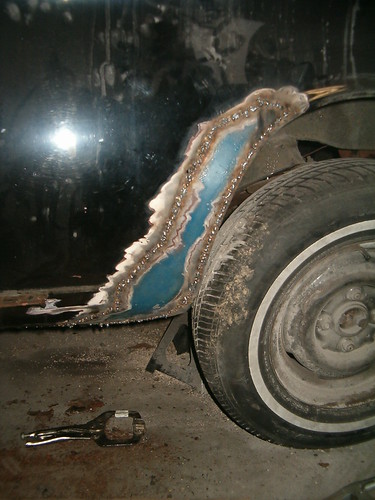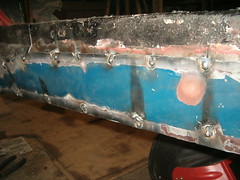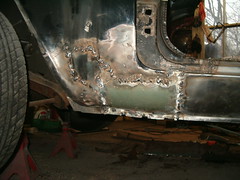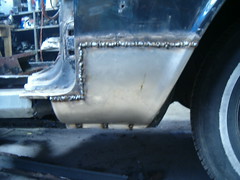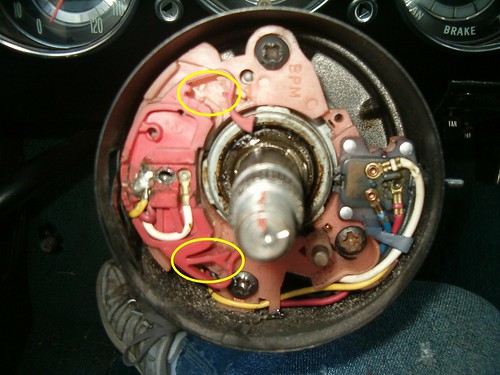
Yesterday Glinda finally got some of my attention. I was tied up with fun stuff with the lovely Loriann until early in the evening, but I did get a few hours of quality time with the ’68. First I removed the steering wheel to determine the issue with the turn signal switch (it won’t latch for a right turn – Victoria has to hold it in place). I found one of the tiny tangs had broken off (see yellow circled areas in the above photo). A Superglue repair wasn’t going to last, so after taking a picture and tightening the lever screw, I put it all back together. I’ll give Jeff at the Corvair Ranch a call and order a replacement part. Clark’s has this piece reproduced, so a GNP will be the best for this application.
While sitting in her driver’s seat, I was reminded of how crappy the rearview looks – lots of the corrosion around the edges. This will be added to the Corvair Ranch order.
Next, was replacing the muffler. I backed the car up onto the ramps and said a prayer that I’d be able to remove the exhaust system without breaking anything. With God’s help and positive properties of the anti-seize, I dropped the exhaust pipe-muffler-tail pipe assembly with the only casualty being a ripped rear mounting plate. It’s the plate that retains the muffler strap. This was easily remedied by drilling a new hole near the old one, and in a more solid portion of the plate. After a quick dinner, I was back on my back in the driveway and about an hour later, the replacement assembly was bolted in place. I turned the car on with it back end still stuck in the air, so I could check for leaks. Not finding any, I drove her off the ramps and took her for a spin around the neighborhood. I really like the throttle response of this engine. If only I could succeed in squeezing a few more MPGs out of it, I’d be satisfied.
While I had the engine lid open, I did a cursory glance check of things. With the oil level at the add mark, I had Victoria put a quart of oil in the crankcase this morning. I checked the belt tension and it was fairly loose, so I given the lateness of the hour, I decided to put that adjustment off until the next evening. BIG MISTAKE! Late this morning, I got the call from Victoria, “Dad, the GEN/FAN light is on. I’ve pulled off the road and shut the engine off.” After having her verify that the belt had failed, I told her I’d be there as soon as I could. When I arrived, I found that one end of the broken belt had gone past the fan and been forced into finned volume under the top cover. It took a bit of doing, but I was able to spin the fan and yank on the belt until it came out. I inspected the vanes on the fan and found them undamaged. Whew. As I was installing a spare belt, I explained the process to Victoria and made sure she watched what I was doing. She had pulled three belts out of her trunk, two that had failed and needed to be thrown away and a third that was too long - hmm wonder what that one goes to. I popped Lucy’s trunklid and took out her spare. Too many minutes later, we had the new belt on and the two guards in place – yeah, the guards that were supposed to prevent a belt from popping off. I had Victoria start up the engine only to immediately see the idler pulley was not spinning. With the engine back off, I did a quick diagnosis and found the guard at that location was binding on the pulley wheel diameter. After loosening the hold down nuts and adjusting the guard and retightening the nuts, she was good-to-go.
Now I can add two fanbelts to the Corvair Ranch shopping list. As to what’s causing the problem, I found the two pulley wheel retaining nuts did not seem tight, so I’m going with a loosening of the pulley wheel. Regardless, I told Victoria that we’re to check tension on that belt weekly. I’m also going to do a thorough cleaning of the four pulley grooves to ensure they are rust free. When the belt was off, I made sure the fan, alternator, and pulley wheel all spun freely and silently – they did.

